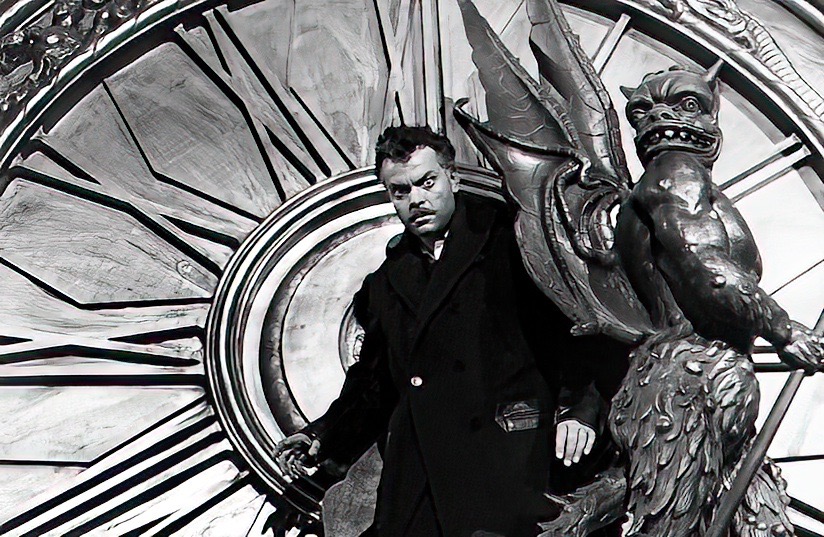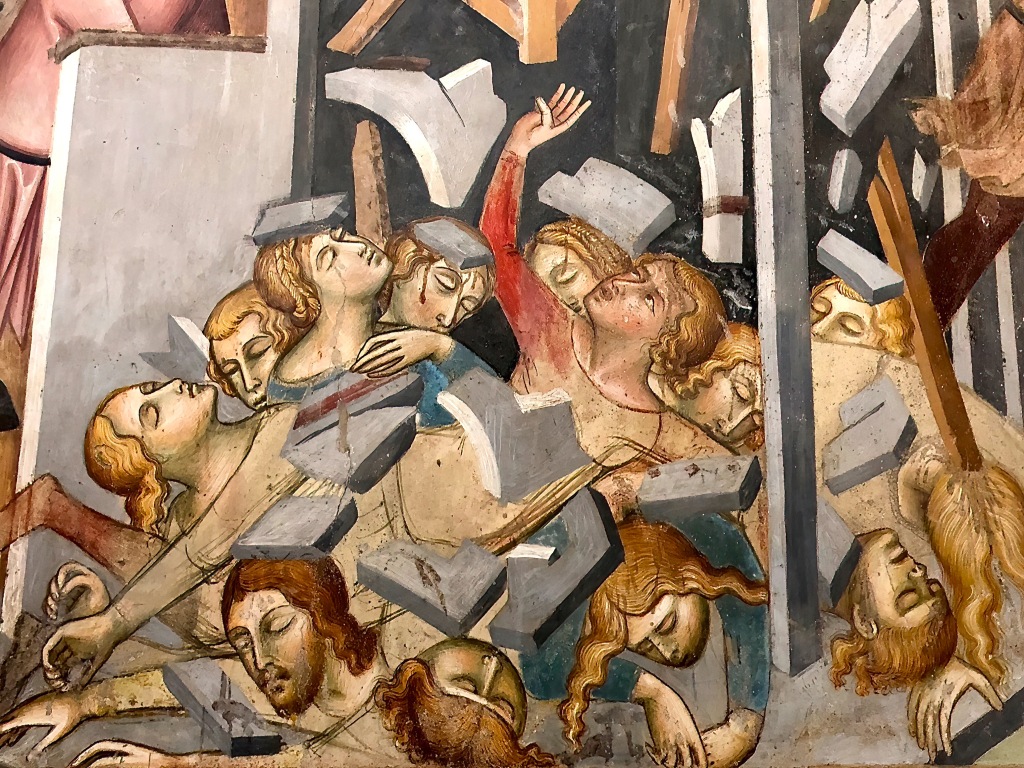Yet saints their watch are keeping,
their cry goes up, “How long?”
and soon the night of weeping
shall be the morn of song.
–– Samuel John Stone
Of all the seasons, Advent is the one I love the best. Its flavors are so richly complex: prophetic shouts and angelic whispers, deepest dark and magical light, wintry cold and warming hearts, the end of the world and the birth of the new. And its symphonic progression, from the eschatological thunder of its opening movement to the midnight hush in the shepherds’ field, sounds the profoundest depths of the cosmos and the soul.
I fell in love with Advent as a child, when I knew no distinction between sacred and profane. The glow of colored lights on almost every house, our family prayers around the Advent wreath, the search for the perfect tree, the interminable wait for presents to be opened, the smell of baking cookies shaped like stars and Santas, the glorious texts of Isaiah and Luke on Sunday mornings, and hearty renditions of “O come, O come, Emmanuel” and “Come, thou long-expected Jesus”––they were all about the same thing: the wonder of a world where magic is afoot and Love’s gifts are never exhausted.
Over the years, as I have grown more acquainted with the sorrow, pain and injustice of mortal life and human history, the meanings of Advent have only deepened. And in today’s evil times, the practice of hope is more necessary than ever.
I have written more posts about Advent than any other season, and I gather all the links together here. Wander through them as you will. Try the practices. Share whatever you like. And may your own Advent bring you blessing, joy, and the nearness of holy Presence.
Practices
Ten Ways to Keep a Holy Advent –– This has been my most popular Advent post, with simple practices to deepen our experience of the season. “In a month that is already far too busy and rushed, these are not offered as one more to-do list to work through, but as ways to slow down, take a breath, pay attention, and make room in our lives for the birth of the Holy.” The 10 ways are: Interrupting, Silencing, Waiting, Listening, Watching, Praying, Reflecting, Loving, Giving, Receiving. (Dec. 6, 2014)
Praying the O Antiphons –– These sublime antiphons (best known in the hymn, “O come, O come, Emmanuel”) are a beautiful way to pray during Advent. This post includes my contemporary variations on the ancient texts. On each of the seven days before Christmas, put the appropriate antiphon on your mirror or refrigerator, and pray without ceasing. (Dec. 17, 2014)
The O Antiphons: Drenched in the Speech of God –– Further reflections on what the antiphons have to tell us. “God is not a hypothesis to be tested or a puzzle to be solved by detached observers, but an experience to be encountered by receptive participants, those who know how to say ‘O!’” (Dec. 17, 2015)
Short Meditations on the O Antiphons —The link will take you to December, 2019. Daily meditations are posted from Dec.16-23..
Prayers for the Advent Season — Intercessions for use in the liturgies of Advent. (Nov. 30, 2018)
Theology
Dancing with Time: An Advent Prelude –– A meditation on time, a major preoccupation of the season. As W. H. Auden said, “Time is our choice of How to love and Why.” (Dec. 1, 2017)
The World’s End (An Advent Manifesto) –– Worlds end all the time. Neither personal worlds nor public worlds last forever. That may bring sadness, but it is also the foundation of hope’s possiblities. “Yes, all the inadequate, incomplete versions of world will come to an end (some of them kicking and screaming!), but creation as it was intended will be restored, not discarded. Like a poet who creates a new language out of old words, Love will remake the ruins and recover the lost. And the Holy One who is the mystery of the world will be its light and its life forever.” (Nov. 25, 2016)
Blinded by the Light: An Advent Meditation — The mystery we call God is always beyond us. Beyond our grasp, beyond our language, beyond our sight. The mystics and great spiritual teachers sometime use the word darkness to convey their experience in close encounters with the divine. But what they call the darkness of God is not so much a matter of cognitive deprivation, where divinity simply hides its incommunicable essence from finite minds and hearts unprepared to receive it. No, they say, the darkness of God is not deprivation, but saturation. It is not an absence of light, but an excess of glory, that makes our eyes become so dim to divine presence. (Dec. 2, 2019)
“Hopes that pointed to the clouds”: A Sermon for Advent 1 — How do we sustain hope in apocalyptic times, when the “signs of ending” are all around us and we are discouraged by failed expectations? Jesus and the poets—William Wordsworth, W. H. Auden, and Anne Sexton—help us to take heart in challenging times. (Nov. 28, 2020)
“God Isn’t Fixing This” –– For an Advent liturgy, I constructed an enormous wall, made of newspapers with distressing headlines, and set it as a veil between the congregation and the beauty of the sanctuary. In the course of the liturgy, the wall was torn down, symbolizing God’s grace breaking into our troubled history. As I wrote in this post (after yet another American gun massacre): “What if an unexpected future is breaking through the walls of our self-made prison? The Advent message is to embrace this hope, as we take off the garments of sorrow and affliction to welcome the God of joy into our midst.” (Dec. 15, 2015)
“God is alive, surprising us everywhere” –– “God is alive, surprising us everywhere. The message of a dream, intimating something more real than language. But what? Not an idea in my mind. A feeling in my body. I tried briefly to give it words. Nearness. Urgency. Strength. Presence. Then I let the words go, and rested in whatever it was. In times so dark and dangerous, it felt––consoling. Heaven and earth may pass away, but this Presence will not. We are not alone. Perhaps, even loved.” In the deep gloom after the presidential election, I was given the grace of three small revelations. One came during a concert, one in a dream, and one from the mouth of a homeless woman. (Dec. 13, 2016)
I Say Rejoice: A Homily for Advent 3 (Year C) —People of faith abide in a different story, a story where death does not have the last word, a story where Love wins. To say that God will save us is to belong to that story, and to live accordingly. And what are the fruits of faith’s life-shaping story?––trust, confidence, hope, and the kind of invincible joy which St. Paul proclaims with such passion. “Rejoice! Again I say, rejoice!” (Dec. 15, 2018)
Gaudete! — The Advent Dance of Honesty and Hope — The 3rd Sunday of Advent sounds a note of rejoicing to dispute the wintry gloom. It doesn’t deny the darkness, but it also refuses to accept the black hole of unredeemed history as an inescapable fate. “Stir up your power,” we pray, “and with great might come among us.” God’s power will never compel us to rejoice, or to hope, or to love, but it will always seek to persuade us, until the end of time. (Dec. 10, 2022)
Say Yes: A Homily for Advent 4 (Year C) — When Mary said “Yes” to the angel of the Annunciation, it was neither the first nor the last time she would do so. Her whole life up to that point had been a series of consents that would prepare her to receive the Holy One into herself. And in the years that followed, she never renounced her acceptance of the story that would one day take her weeping to the foot of the cross. It is no light thing to say Yes to such a story. (Dec. 18, 2021)
Worship
Advent Adventures in Worship (Part 1: The Electric Eschaton) –– “As the liturgical season when the old is judged and found wanting and the new is never quite what anyone expects, Advent seems particularly suited to a disruption of routine and the intrusion of novelty into the worship experience.” In the apocalyptic year of 1968, I curated a multi-media Advent mash-up of sounds and images from films, rock and roll, poetry, political documentaries and other diverse sources to evoke two Advent themes: “Break on through to the other side” and “Please don’t be long.” This post includes an unusual 20-minute audio collage which, 49 years later, remains a unique artifact in the history of preaching. Wear headphones and turn it up! (Dec. 13, 2014)
Advent Adventures in Worship (Part 2: Homecoming) –– In a pioneering example of a worship “installation,” people journeyed in small groups through a series of multi-sensory experiences. “The journey was a dying (baptismal figure, narrowing of space, sounds and images of a yearning world, an unknown way, darkness) and a rising (emergence into an open, “transcendent” space, and being gathered into the community of the eucharist). It was a losing (leaving the original assembly and the main space) and a finding (rediscovering the community and the original space).” (Dec. 20, 2014)
Unsilent Night: An Advent Revelation –– In an annual December art experience by musician Phil Kline in cities across America, participants collectively create a river of sound moving through the streets––a striking instance of Advent surprise and wonder. “If God is more of a situation than an object, then the community, relationality, mystery, beauty, wonder, delight, and communion produced by the event seemed apt expressions of divinity taking ‘place,’ or ‘being here now.’ You didn’t have to name it to live it.” (Dec. 21, 2015)






